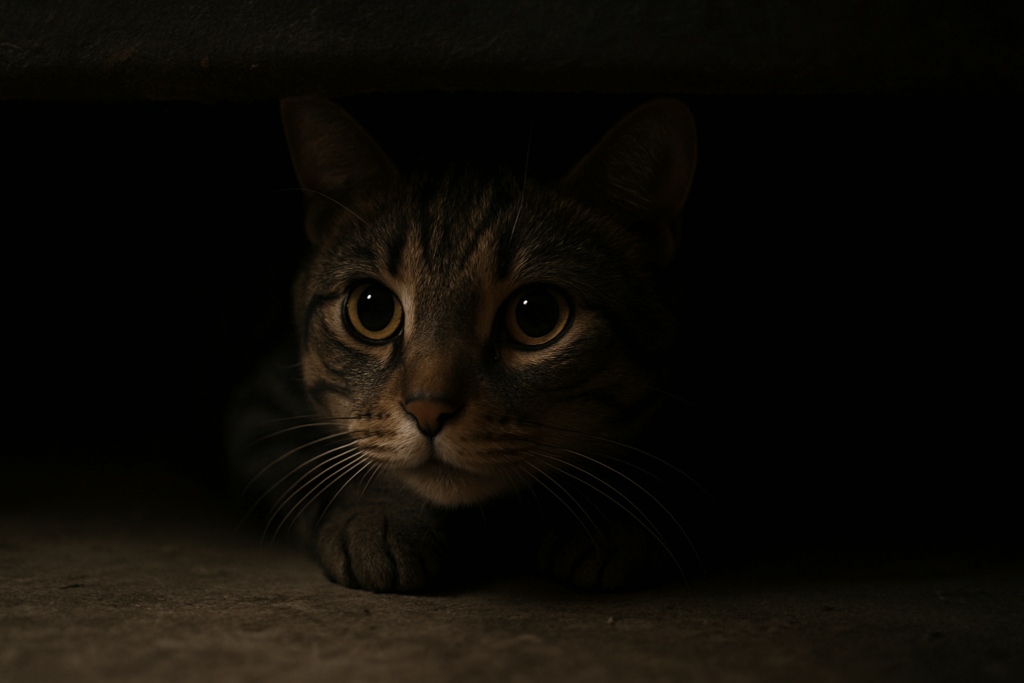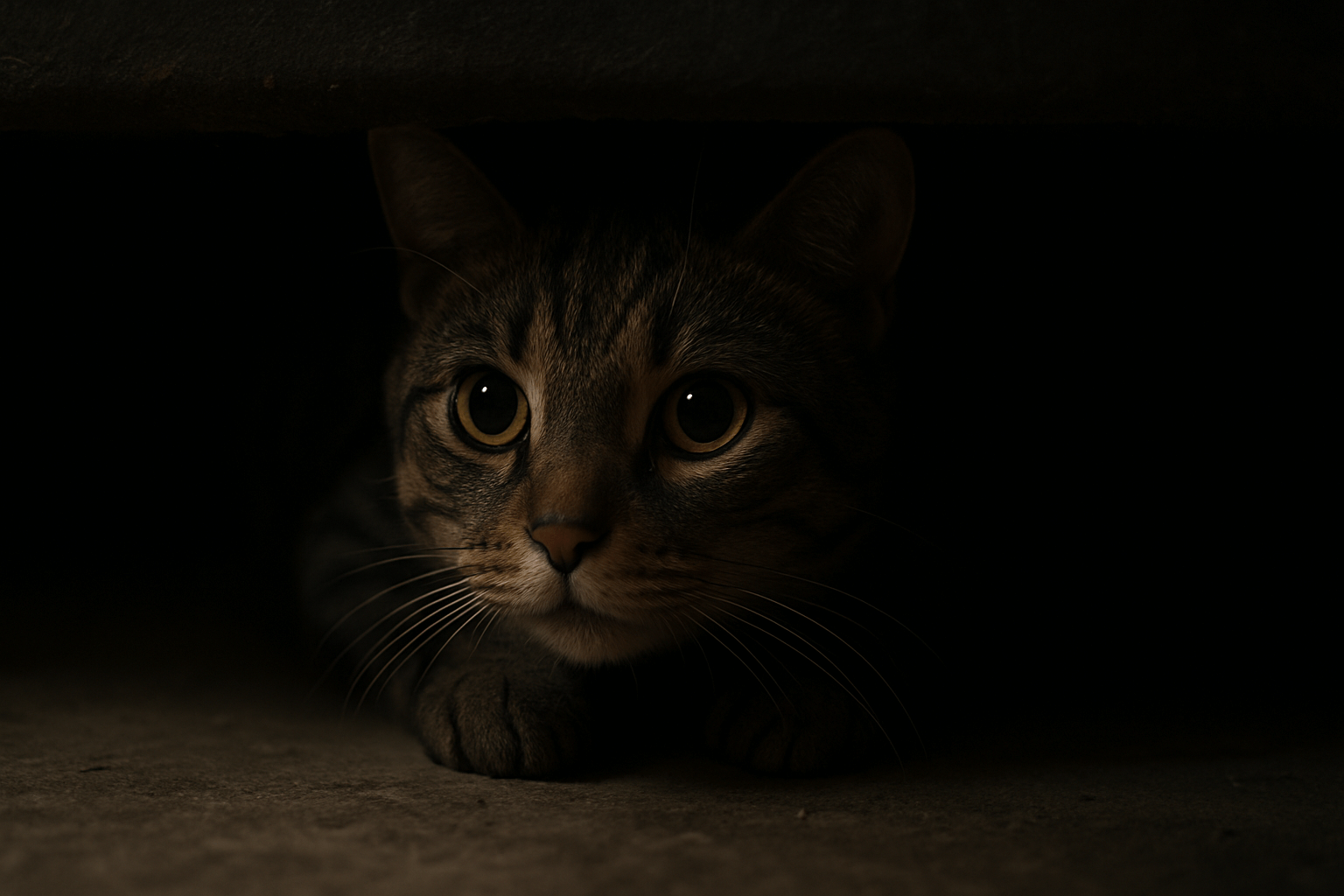My Cat Keeps Hiding in Dark Places: Why It’s Happening and What to Do
Cats love dark corners. Under the bed. Behind the couch. Inside closed cabinets. It’s quiet. It’s safe. It’s theirs. But when your cat keeps hiding in dark places—especially if it’s new, sudden, or accompanied by other changes—it’s not just a preference. It’s a signal. Understanding why your cat hides in dark places isn’t about fixing a habit. It’s about listening to a silent cry for safety, comfort, or care.
The Natural Instinct Behind Hiding in Darkness
Hiding isn’t a flaw—it’s a survival strategy. Cats are both predators and prey, and darkness offers them the ultimate refuge. Here’s why your cat is drawn to shadows:
Safety and Security:
In the wild, darkness conceals cats from larger predators. Even domesticated, your cat’s instincts still crave enclosed, low-light spaces to feel protected.Sensory Control:
Dark spaces reduce visual stimulation, helping cats feel less overwhelmed by noise, movement, or unfamiliar people.Thermal Comfort:
Enclosed dark areas often retain warmth better than open, lit rooms—perfect for a cat seeking cozy, stable temperatures.Stress Reduction:
When anxious, cats retreat to quiet, dim places to regulate their nervous system and regain emotional balance.Rest and Recovery:
Cats sleep 12–16 hours a day. Dark, quiet spots are ideal for deep, uninterrupted rest, especially after exertion or illness.
Your cat isn’t being shy or moody. They’re following a deeply wired blueprint for survival. Hiding is normal—until it becomes constant, fearful, or accompanied by other warning signs.

When Hiding Becomes a Red Flag: Signs of Underlying Issues
While occasional hiding is healthy, persistent or extreme hiding in dark places can indicate pain, fear, or illness. Watch for these critical indicators:
Avoiding Interaction Entirely:
If your cat no longer greets you, ignores treats, or flees at the sound of your voice, they’re not just resting—they’re withdrawing.Changes in Appetite or Litter Use:
A cat hiding and refusing food, water, or the litter box is signaling distress—possibly illness or severe anxiety.Hiding in Unusual Locations:
Behind the fridge, inside a drawer, or under heavy furniture isn’t just “dark”—it’s extreme. This suggests fear or physical discomfort.Body Language of Fear:
Tucked tail, flattened ears, dilated pupils, or hissing when approached mean your cat feels threatened, not simply relaxed.Duration Beyond 48 Hours:
If your cat stays hidden for more than two full days without emerging—even to eat or use the litter box—it’s time to act.
This isn’t “just a phase.” It’s a behavioral alarm. Ignoring it can delay diagnosis of serious conditions like kidney disease, hyperthyroidism, or neurological issues.
Check this guide 👉Cat Hiding Places: Best 7 Expert Tips!
Check this guide 👉Why Is My Cat Hiding Under the Bed? Best 7 Tips!
Check this guide 👉My New Cat Is Hiding and Not Eating: Best 7 Expert Tips!
| Normal Hiding Behavior | Concerning Hiding Behavior |
|---|---|
| Brief retreats after play or loud noises | Constant hiding for more than 48 hours |
| Emerges willingly for food, affection, or play | Refuses food, water, or litter box use |
| Chooses familiar, accessible spots (under bed, behind couch) | Hides in isolated, hard-to-reach places (inside walls, behind appliances) |
| Body language is relaxed when not hiding | Constantly tense, trembling, or avoiding eye contact |
| Returns to normal routine within hours | Shows weight loss, vomiting, or lethargy alongside hiding |
Common Triggers That Make Cats Hide in the Dark
Cats don’t hide without reason. Even if the trigger seems small to you, it’s monumental to them. Here are the most frequent causes:
New People or Pets:
A visitor, baby, or new animal in the home can trigger territorial anxiety and retreat into darkness.Loud Noises:
Fireworks, construction, vacuuming, or even a slamming door can send a sensitive cat into hiding for days.Changes in Routine:
Moving furniture, altering feeding times, or switching to a new litter brand can disrupt a cat’s sense of safety.Illness or Pain:
Cats instinctively hide when they feel unwell. Arthritis, dental pain, or urinary infections make them want to disappear.Past Trauma or Abuse:
Cats with histories of neglect or abuse often retreat to dark corners as a lifelong coping mechanism.
The key isn’t to eliminate these triggers entirely—it’s to recognize them and help your cat feel secure despite them.
How to Create Safe, Dark Spaces—Without Encouraging Fear
You don’t need to ban dark corners. You need to design them wisely. Here’s how to support your cat’s need for privacy while keeping them healthy:
Designate a “Safe Zone”:
Set up a quiet room with a covered bed, soft blanket, water, and litter box—no foot traffic, no noise.Use Cat-Approved Hiding Spots:
Invest in enclosed cat beds, tunnels, or cardboard boxes with soft lining. Make them inviting, not just functional.Keep Lighting Low, Not Pitch Black:
Use dim nightlights near hiding spots so your cat isn’t disoriented when emerging.Avoid Forcing Them Out:
Never pull or chase a hiding cat. Let them choose when to re-emerge. Trust is rebuilt through patience.Use Calming Scents:
Feliway diffusers or lavender-scented sprays (cat-safe only) can reduce anxiety and encourage exploration.
Your goal isn’t to stop hiding—it’s to ensure your cat hides safely, and knows they can come out without fear.
What to Do When Your Cat Won’t Come Out
If your cat has been hiding for more than a day and won’t respond to treats, voice, or touch, here’s what to do:
Check for Physical Signs of Illness:
Look for labored breathing, vomiting, diarrhea, or difficulty walking. These require immediate vet attention.Leave Food and Water Near the Hiding Spot:
Place bowls just outside the entrance. Don’t enter the space—let them come to you.Sit Quietly Nearby:
Read aloud, play soft music, or simply sit on the floor. Your presence is calming—even if they don’t acknowledge you.Avoid Sudden Movements or Loud Voices:
Speak in a low, soothing tone. Sudden actions will reinforce their fear.Document Behavior:
Note duration, location, appetite, litter use, and any changes. This info is vital for your vet.
If after 48 hours your cat still refuses to emerge, schedule a veterinary visit. This isn’t stubbornness—it’s a medical red flag.
How to Rebuild Trust After Trauma or Stress
Cats who hide due to past trauma or major stress need gentle, consistent reassurance. Recovery takes time—but it’s possible.
Establish Predictable Routines:
Feed, play, and sleep at the same times daily. Predictability = safety.Use Positive Associations:
Offer favorite treats or toys only near their safe space—not to lure them out, but to build trust over time.Engage in Gentle Play:
Use wand toys from a distance. Let them initiate contact. Reward curiosity with praise, not pressure.Limit Visitors and Noise:
For the first few weeks, keep the home quiet. Only allow calm, familiar people near the cat.Consider Behavioral Therapy:
Some cats benefit from certified feline behaviorists who specialize in anxiety and fear-based behaviors.
Healing isn’t fast. But with patience, your cat will learn that the world beyond the dark isn’t dangerous—it’s peaceful.
Myths About Cats Who Hide in the Dark
Don’t let myths prevent you from helping your cat. Here’s what you need to unlearn:
Myth: “They’re just shy.”
Shyness doesn’t cause 12-hour hiding spells. Fear, pain, or illness does.Myth: “Cats hide because they’re mad at you.”
Cats don’t hold grudges. They react to environment and emotion—not spite.Myth: “They’ll come out when they’re ready.”
Sometimes yes. But if they’re hiding due to illness, “ready” might never come without intervention.Myth: “Dark spaces are bad for cats.”
No. It’s isolation and lack of choice that’s harmful—not darkness itself.Myth: “Declawing or confinement will fix hiding.”
Confinement increases fear. Declawing causes chronic pain. Both worsen hiding behavior.
Your cat isn’t broken. They’re communicating. Learn the language.
FAQ: My Cat Keeps Hiding in Dark Places
Is it normal for my cat to hide every night?
Yes—if they emerge in the morning, eat normally, and show no signs of fear. Many cats are crepuscular and prefer quiet, dark hours to rest.
Why does my cat hide under the bed specifically?
Under-bed spaces offer darkness, warmth, enclosure, and a sense of being “hidden in plain sight.” It’s the perfect feline sanctuary.
Can a new cat hide for weeks?
Yes. New cats often hide for days or even weeks while adjusting. Provide a safe room and give them time—up to 2–4 weeks—for full acclimation.
Should I try to lure my cat out with treats?
Only if they’re already showing signs of willingness. Forcing them with treats can increase stress. Let them choose.
Does hiding mean my cat is depressed?
Possibly. Prolonged hiding, lack of interest in play, and appetite loss are signs of feline depression or anxiety. Consult your vet.
Let Them Find Their Light—On Their Own Terms
Your cat doesn’t hide because they’re afraid of you. They hide because the world feels too loud, too bright, too much. And in those dark corners, they find peace.
Your job isn’t to drag them into the light.
It’s to make sure the light is always there—gentle, warm, and waiting.
To leave a trail of treats near their safe spot.
To sit quietly in the room, reading aloud.
To never punish, never rush, never force.
Canned Pumpkin for Cat Diarrhea: Best 7 Expert Tips! Natural remedy to firm stools, soothe upset bellies, and support gut health safely.
Can a Cat Give You Scabies? Best 7 Expert Tips! Discover the truth about feline mites, human skin risks, and how to protect yourself—without panic.
Cat Flea vs Human Flea: Best 7 Expert Tips! Discover the truth about bites, species, and how to eliminate infestations for good.
Weird Cat Behaviors: Best 7 Expert Tips! Discover why cats do strange things—and how to understand, not punish, their instincts for a happier home.





